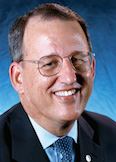Making an Impact
Posted on Jan. 15, 2008Some years ago, Stanford’s president was asked whether it was true that the university planned a $1 billion fundraising campaign. His reported response: Stanford certainly would continue to raise money — more than ever — but it might not announce a goal.Why? Too much attention, he argued, can be given to a campaign’s financial goal, particularly in making comparisons to rival institutions, and too little can be placed on the impact of the funds raised.

Doug Dibbert ’70
The impact and leverage of each private gift can be lost in a quick overview of the numbers associated with the success of the Carolina First Campaign, which concluded Dec. 31. Private gifts have been partnered with state appropriations to fund more than 200 new endowed professorships, which help the University recruit and retain distinguished faculty. Voter approval of the 2000 Higher Education Bonds, coupled with state appropriations and private gifts, have made it possible to renovate and build much-needed classroom and research facilities across the campus. Gifts have made it possible to broaden the pioneering Carolina Covenant program and expand it to more students, and the Honors Program has been increased by a third. Such gifts also have funded nearly 200 new graduate fellowships and more than 550 new undergraduate scholarships.
It is helpful to put Carolina First in perspective. In the mid-1970s, when the late Chancellor Ferebee Taylor ’42 announced Carolina’s first capital campaign — the Carolina Challenge — the goal was $100 million. He received appeals from basketball fans for the campaign to include a funding objective to replace the cramped but intimate Carmichael Auditorium. Taylor said no, insisting that the first campuswide capital campaign should focus only on academic needs. (Carolina First included and exceeded a $175 million goal for athletics.)
In the mid-’80s, in anticipation of the Bicentennial Campaign, candidates were interviewed for the position of vice chancellor for development and University relations. They were informed that since Carolina soon would be observing its 200th anniversary, it was thought the campaign’s fundraising goal should be $200 million. Gary Evans, who was selected by then-Chancellor Chris Fordham ’47 for the job, responded: “I’m certainly glad Carolina isn’t going to be celebrating its 400th anniversary.”
It’s now 2008. And for the first time since June 1999, the University is not conducting a campuswide fundraising campaign.The original $1.8 billion goal for Carolina First was increased to $2 billion, and, as this magazine went to press, estimates were that by the campaign’s close more than $2.3 billion would have been raised. Representing $500 million more than the original goal, this increase also far exceeds the $440 million raised during the entire Bicentennial Campaign, which was conducted from July 1989 through June 1995. In fiscal 2006-07, Carolina raised nearly three times what was raised in the last fiscal year of the Bicentennial Campaign.
Some may be concerned that the end of Carolina First could result in fewer contributions. But, in fact, in every year that followed the Bicentennial Campaign, Carolina raised more money than it had in any year during the Bicentennial Campaign. Carolina’s opportunities, challenges and needs aren’t exhausted with the conclusion of a campaign, and Carolina isn’t reducing its fundraising staff or its focus on private giving.
From fiscal 1989-90 through fiscal 2006-07, the average annual growth rate in private gifts to Carolina was 9.9 percent (now totaling $256 million) compared with an annual growth rate of 4.1 percent in state appropriations (now totaling $492 million), 8.6 percent in government contracts and grants (now totaling $536 million) and 10.8 percent in tuition and fees (now totaling $262 million). Carolina’s remarkable partnership with taxpayers, students and parents, faculty, alumni and friends makes it possible for Carolina to remain competitive.
The General Alumni Association is proud to have been an important contributor to the Carolina First Campaign’s success. GAA programs, records and publications have been essential to inform and involve alumni. Of the money given by Carolina alumni to the Carolina First Campaign, nearly 90 percent has come from Carolina Alumni members.
As planning begins for what certainly will become Carolina’s next campuswide campaign, we should take time to celebrate what has been achieved through the sustained efforts of many people over many years. Every gift is important regardless of its size, and each of us benefits as the value of our Carolina diploma continues to appreciate.
Yours at Carolina,

Douglas S. Dibbert ’70
